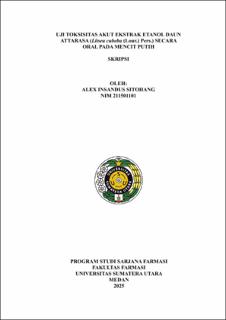Uji Toksisitas Akut Ekstrak Etanol Daun Attarasa (Litsea Cubeba (Lour.) Pers.) Secara Oral pada Mencit Putih
Acute Toxicity Test of Etanol Extract of Attarasa Leaves (Litsea cubeba (Lour.) Pers.) Orally in White Mice

Date
2025Author
Sitohang, Alex Insandus
Advisor(s)
Surbakti, Chemayanti
Syahputra, Rony Abdi
Metadata
Show full item recordAbstract
Background: Attarasa (Litsea cubeba (Lour.) Pers.) is a plant widely found in Indonesia, particularly North Tapanuli, and is used as a traditional medicine. This study evaluated the acute toxicity of ethanol extract of attarasa leaves (EEAL) in male and female mice.
Objective: To provide toxicological information of EEAL as a basis for clinical trials and community utilization.
Methods: Mice were given EEAL doses of 2000 mg/kg BW and 5000 mg/kg BW for 14 days, compared with the control group. Parameters assessed included body weight, food and water intake, organ weight (heart, liver, kidney), and ureum, creatinine, SGOT, and SGPT levels. Data were analyzed using GraphPad version 9.0.
Results: The results of the phytochemical screening test identified secondary metabolite compounds, namely alkaloids, flavonoids, glycosides, saponins, terpenoids, and tannins. The results of the toxicity test showed no toxic symptoms in the treatment group, although there were fluctuations in body weight and weight loss in female mice at a dose of 2000 mg/kg BW. There were no significant differences in relative organ weight, ureum, creatinine, and SGPT (p > 0.05). However, SGOT levels of female mice at 5000 mg/kg BW showed significant differences (p ≤ 0.05), indicating the potential for acute toxicity.
Conclusion: EEDA does not cause acute toxicity in mice, except for the potentially toxic SGOT levels of female mice at a dose of 5000 mg/kg BW.
Collections
- Undergraduate Theses [1818]
